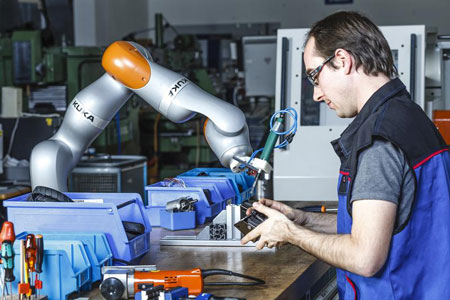| Mar 18, 2014 |
Human-robot interaction: sensor-controlled assembly
|
|
(Nanowerk News) At a joint stand of the European research initiative SMErobotics at the 6th International Trade Fair for Automation and Mechatronics, scientists from Fraunhofer IPA will demonstrate a sensor-controlled lightweight assembly robot that allows the high-quality, profitable automation of previously manual assembly processes, especially in the small-scale production sector. The focus is on effective human-robot interaction at a workstation similar to those on a shop floor, the goal being to enable the worker to easily program the robot and use it intuitively like a tool.
|
 |
| Sensor-controlled assembly.
|
|
Growing cost pressure, short product life cycles and high product diversity call for flexible and cost-effective assembly systems that can be quickly adapted to suit changed requirements. Scientists at Fraunhofer IPA have developed a sensor-controlled assembly process that makes it possible for workpieces to be localized and positioned. Work-holding fixtures are extensively replaced by sensors, this offering flexibility at low cost. Other advantages are that the robot is designed to be easily programmable and capable of dealing with tolerances.
|
|
Using a robot as a tool
|
|
“Our aim is to demonstrate that sensor-controlled robots are capable of coping with modern-day conditions at manual assembly workstations, such as chaotically arranged components,” says Martin Naumann, Group Leader in the Robot and Assistance Systems department at Fraunhofer IPA. The emphasis is on effective human-robot interaction. Selected assembly processes are carried out manually, while others are automated. The robot is intended to be used as a tool.
|
|
At the joint stand of the European research initiative SMErobotics, Fraunhofer IPA will demonstrate sensor-controlled assembly in a robot cell with the KUKA LBR iiwa.
|
|
“At a manual workstation, we’ll use the lightweight robot to carry out riveting processes as an example. However, the underlying concepts can equally well be applied to other assembly processes,” explains Naumann.
|
|
The components are made available within the robot’s working area without the need for any separate work-holding fixture. The robot moves to the determined location and localizes the exact riveting position on the component using a stereo camera integrated in the robotic tool.
|
|
“We’re highly interested in transferring the exhibited solution to new applications – especially at small and medium-sized manufacturing enterprises, where manual work processes prevail,” says Naumann.
|

